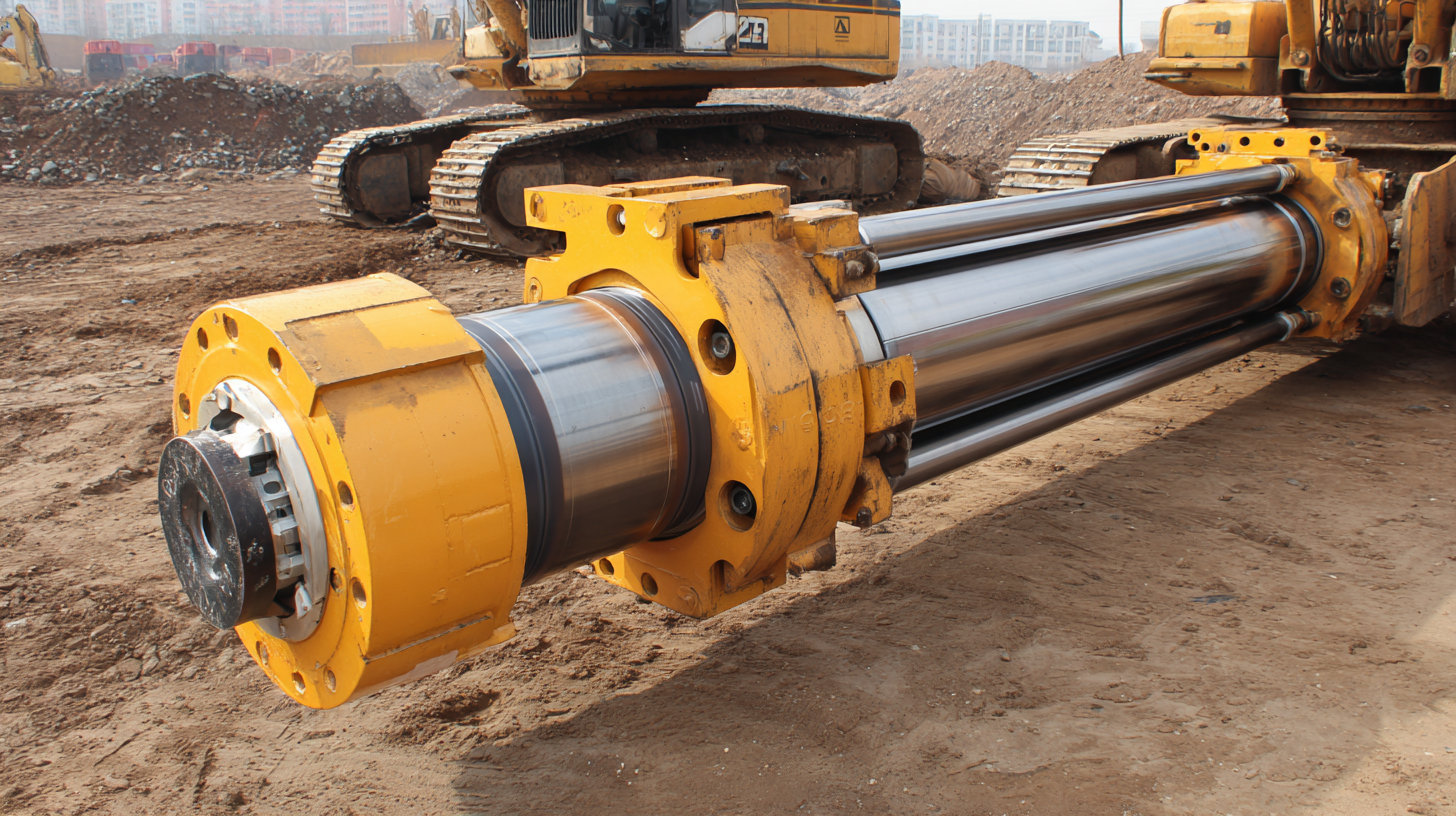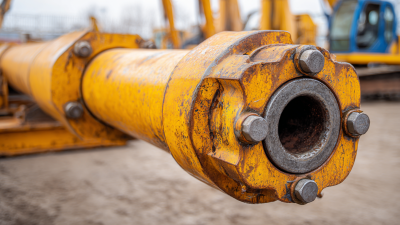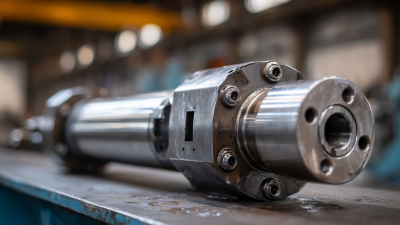
Why Choosing the Right Hydraulic Cylinder for Your Excavator Matters
Choosing the right hydraulic cylinder for your excavator is crucial for optimizing performance and safety in any heavy-duty operation. As industry expert John Smith, a leading engineer at Excavation Dynamics, emphasizes, "The hydraulic cylinder is the powerhouse of an excavator; selecting the correct type significantly impacts efficiency and reliability." This highlights the importance of making informed decisions when it comes to hydraulic components, especially in a field where precision and durability are paramount.
Hydraulic cylinders are integral to providing the necessary power and movement in excavators, affecting everything from digging capabilities to overall machine longevity. Understanding the different types and specifications of hydraulic cylinders for excavators can make a tangible difference not only in operational efficiency but also in minimizing downtime and repair costs. By investing time in selecting the appropriate hydraulic cylinder, operators can ensure their machinery runs optimally, safeguarding both their investment and the success of their projects.
In this discussion, we will explore the critical factors involved in choosing the ideal hydraulic cylinder for excavators, noting how these choices influence performance, safety, and cost-effectiveness in various excavation tasks.

The Critical Role of Hydraulic Cylinder Specifications in Excavator Performance
Choosing the right hydraulic cylinder plays a pivotal role in optimizing excavator performance, particularly given the increasing demands of construction projects. Hydraulic cylinders are essential for controlling the movement and operation of the excavator’s arm and bucket, impacting efficiency and power. According to recent industry reports, excavators equipped with high-performance hydraulic cylinders demonstrate up to 25% enhanced digging capability compared to those with standard specifications. This increase not only accelerates project timelines but also maximizes productivity in various operational environments.

With advancements in hydraulic technologies, manufacturers are focusing on tailored solutions that enhance performance metrics. The latest range of excavators now incorporates more fuel-efficient systems and improved hydraulic specifications that contribute directly to operational efficiency. Enhanced robustness in hydraulic components can lead to a 15% reduction in maintenance costs, underscoring the significance of selecting the right hydraulic cylinder for optimal performance. As excavators increasingly leverage smart technologies, the importance of precise hydraulic cylinder specifications becomes evident in achieving greater accuracy and control in excavation tasks.
Top 5 Factors to Consider When Selecting Hydraulic Cylinders for Your Excavator
When selecting hydraulic cylinders for your excavator, several critical factors come into play that can significantly impact performance and efficiency. First and foremost, the cylinder size and bore diameter must be appropriate for the intended application. According to a report by the American Society of Mechanical Engineers (ASME), optimal cylinder sizing can enhance lifting and digging capabilities by up to 20%, directly influencing productivity and fuel efficiency.

Another vital factor is the operating pressure of the hydraulic system. Most modern excavators operate within a pressure range of 3,000-5,000 PSI. Selecting a hydraulic cylinder that can accommodate this pressure without compromising durability is essential. A study from the Hydraulic Institute indicates that using a cylinder specifically designed for high-pressure applications can extend service life by 30%, reducing downtime and maintenance costs over time.
Lastly, consider the material and design of the hydraulic cylinder. Materials that resist corrosion and wear, such as hardened steel or composite coatings, can significantly extend the lifespan of the cylinder. Research by the International Hydraulics Association suggests that cylinders made from advanced materials can improve resistance to fatigue, making them an ideal choice for harsh working environments. Being mindful of these factors can lead to enhanced performance and longevity of your excavator's hydraulic systems.
Why Hydraulic Cylinder Quality Can Make or Break Your Excavator’s Efficiency
The quality of hydraulic cylinders is pivotal to the overall efficiency of an excavator. A superior hydraulic cylinder can enhance the machine's performance by delivering higher lifting power and smoother operation. When hydraulic systems function optimally, excavators can execute tasks more effectively, reducing downtime and increasing productivity. Poor-quality cylinders, on the other hand, can lead to leaks, inconsistent power delivery, and even premature failure, which can severely impact operational capacity.
Choosing the right hydraulic cylinder also affects maintenance costs and the longevity of the excavator. High-quality cylinders are often designed to withstand extreme conditions and heavy loads, meaning they require less frequent replacements and repairs. Investing in a reliable hydraulic cylinder not only ensures better performance but also translates into long-term savings for operators. In a competitive industry where time is money, the overall efficiency derived from selecting the right hydraulic cylinder can make a significant difference in project outcomes.
Impact of Hydraulic Cylinder Quality on Excavator Efficiency
The bar chart above illustrates the impact of hydraulic cylinder quality on excavator efficiency. As the quality of the hydraulic cylinder increases, so does the efficiency of the excavator, reaching up to 95% for high-quality cylinders.
How the Right Hydraulic Cylinder Improves Operational Safety and Longevity
Selecting the appropriate hydraulic cylinder for your excavator is crucial not only for performance but also for operational safety and longevity. Hydraulic cylinders are pivotal in controlling the movement and force exerted by heavy equipment. According to a report by the International Journal of Engineering Research and Applications, improper cylinder selection can lead to up to a 30% increase in operational risk and potential equipment failure. Choosing high-quality hydraulic cylinders that match the specifications of your excavator ensures smoother operations and minimizes the risk of malfunction that can jeopardize safety.
To ensure optimal performance, regularly inspect hydraulic cylinders for leaks and signs of wear. Maintenance practices, such as pressure testing and fluid analysis, help identify potential issues before they escalate. It’s reported by Hydraulic & Pneumatics magazine that preventive maintenance can extend the life of your hydraulic systems by as much as 50%, emphasizing the importance of using the right components and adhering to maintenance schedules.
Additionally, consider the load ratings and environmental conditions when selecting your hydraulic cylinder. A mismatch in these parameters can result in catastrophic failures. As a tip, always consult with manufacturers' guidelines and experts to ensure compatibility with your specific excavator model, thus enhancing both safety and performance longevity.
Understanding the Impact of Hydraulic Cylinder Size on Excavator Stability and Power
The size of hydraulic cylinders plays a crucial role in the overall stability and power of an excavator. A correctly sized hydraulic cylinder ensures that the machine operates efficiently, providing the necessary lifting force while maintaining balance. If the cylinder is too small, it may struggle to lift heavy loads, leading to performance issues and potential safety hazards. Conversely, an oversized cylinder can disrupt the machine’s center of gravity, increasing the risk of tipping during operation.
Moreover, the hydraulic cylinder's size affects the speed and responsiveness of the excavator's movements. Larger cylinders can deliver more power, enabling quicker movements and greater force application, which is essential when engaging with tough materials. However, this must be balanced with stability; if the excavator experiences excessive speed without proper control, it can lead to instability and reduced operational safety. Thus, selecting the right hydraulic cylinder size is vital for ensuring that the excavator functions efficiently while safely handling various tasks.
Why Choosing the Right Hydraulic Cylinder for Your Excavator Matters - Understanding the Impact of Hydraulic Cylinder Size on Excavator Stability and Power
| Cylinder Size (Diameter x Stroke) | Lift Capacity (tons) | Max Pressure (psi) | Stability Rating (1-10) | Power Efficiency (%) |
|---|---|---|---|---|
| 100 mm x 300 mm | 8 | 2500 | 7 | 85 |
| 120 mm x 400 mm | 10 | 3000 | 8 | 88 |
| 150 mm x 450 mm | 12 | 3500 | 9 | 90 |
| 180 mm x 500 mm | 15 | 4000 | 10 | 92 |
Related Posts
-

Innovative Solutions for Hydraulic Cylinder For Excavator Enhancing Performance and Longevity
-

A Comprehensive Guide to Selecting the Best Hydraulic Cylinder for Your Trailer Needs
-

Ultimate Guide to Choosing the Right Hydraulic Cylinder for Excavators with Key Specs and Tips
-

Ultimate Guide to Choosing the Best Hydraulic Oil Cylinder for Your Needs
-

Ultimate Checklist for Choosing the Right Hydraulic Cylinder for Your Forklift
-

Top Strategies for Enhancing Performance of Hydraulic Oil Cylinders
